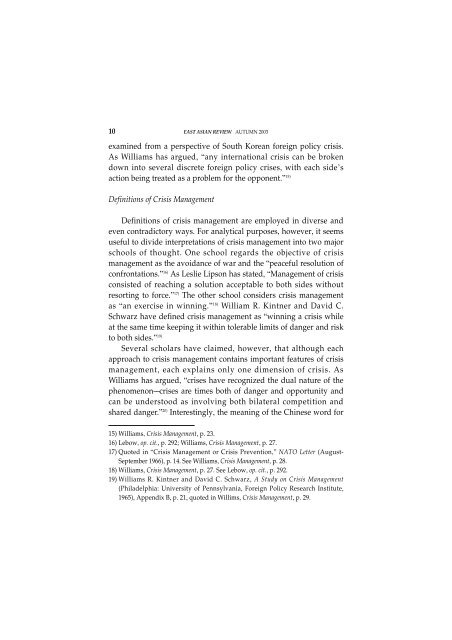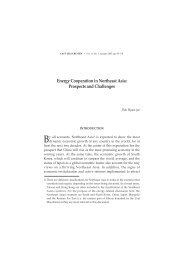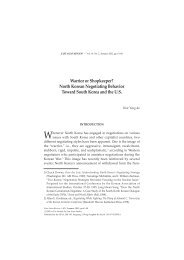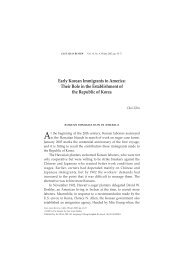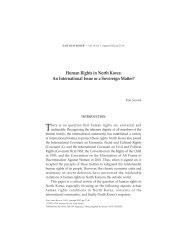Between Peace and War: South Korea's Crisis Management ...
Between Peace and War: South Korea's Crisis Management ...
Between Peace and War: South Korea's Crisis Management ...
You also want an ePaper? Increase the reach of your titles
YUMPU automatically turns print PDFs into web optimized ePapers that Google loves.
10 EAST ASIAN REVIEW AUTUMN 2003<br />
examined from a perspective of <strong>South</strong> Korean foreign policy crisis.<br />
As Williams has argued, “any international crisis can be broken<br />
down into several discrete foreign policy crises, with each side’s<br />
action being treated as a problem for the opponent.” 15)<br />
Definitions of <strong>Crisis</strong> <strong>Management</strong><br />
Definitions of crisis management are employed in diverse <strong>and</strong><br />
even contradictory ways. For analytical purposes, however, it seems<br />
useful to divide interpretations of crisis management into two major<br />
schools of thought. One school regards the objective of crisis<br />
management as the avoidance of war <strong>and</strong> the “peaceful resolution of<br />
confrontations.” 16) As Leslie Lipson has stated, “<strong>Management</strong> of crisis<br />
consisted of reaching a solution acceptable to both sides without<br />
resorting to force.” 17) The other school considers crisis management<br />
as “an exercise in winning.” 18) William R. Kintner <strong>and</strong> David C.<br />
Schwarz have defined crisis management as “winning a crisis while<br />
at the same time keeping it within tolerable limits of danger <strong>and</strong> risk<br />
to both sides.” 19)<br />
Several scholars have claimed, however, that although each<br />
approach to crisis management contains important features of crisis<br />
management, each explains only one dimension of crisis. As<br />
Williams has argued, “crises have recognized the dual nature of the<br />
phenomenon––crises are times both of danger <strong>and</strong> opportunity <strong>and</strong><br />
can be understood as involving both bilateral competition <strong>and</strong><br />
shared danger.” 20) Interestingly, the meaning of the Chinese word for<br />
15) Williams, <strong>Crisis</strong> <strong>Management</strong>, p. 23.<br />
16) Lebow, op. cit., p. 292; Williams, <strong>Crisis</strong> <strong>Management</strong>, p. 27.<br />
17) Quoted in “<strong>Crisis</strong> <strong>Management</strong> or <strong>Crisis</strong> Prevention,” NATO Letter (August-<br />
September 1966), p. 14. See Williams, <strong>Crisis</strong> <strong>Management</strong>, p. 28.<br />
18) Williams, <strong>Crisis</strong> <strong>Management</strong>, p. 27. See Lebow, op. cit., p. 292.<br />
19) Williams R. Kintner <strong>and</strong> David C. Schwarz, A Study on <strong>Crisis</strong> <strong>Management</strong><br />
(Philadelphia: University of Pennsylvania, Foreign Policy Research Institute,<br />
1965), Appendix B, p. 21, quoted in Willims, <strong>Crisis</strong> <strong>Management</strong>, p. 29.


